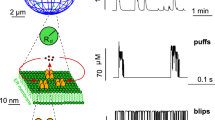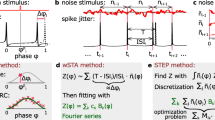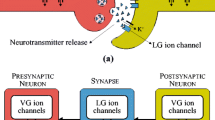Abstract
We use conductance based neuron models, and the mathematical modeling of optogenetics to define controlled neuron models and we address the minimal time control of these affine systems for the first spike from equilibrium. We apply tools of geometric optimal control theory to study singular extremals, and we implement a direct method to compute optimal controls. When the system is too large to theoretically investigate the existence of singular optimal controls, we observe numerically the optimal bang–bang controls.



















Similar content being viewed by others
References
Adamantidis AR, Zhang F, Aravanis AM, Deisseroth K, de Lecea L (2007) Neural substrates of awakening probed with optogentic control of hypocretin neurons. Nature 450:420–424
Bonnard B, Kupka I (1993) Théories des singularités de l’application entrée/sortie et optimalité des trajectoires singulières dans le problème du temps minimal. Forum Math 5:111–159
Boyden ES (2015) Optogenetics and the future of neuroscience. Nat Neurosci 18:1200–1201
Boyden ES, Zhang F, Bamberg E, Nagel G, Deisseroth K (2005) Millisecond-timescale, genetically targeted optical contro of neural activity. Nat Neurosci 8(9):1263–1268
Brown E, Moehlis J, Holmes P (2004) On the phase reduction and response dynamics of neural oscillator populations. Neural Comput 16(4):673–715
Chen Y, Xiong M, Zhang SC (2015) Illuminating Parkinson’s therapy with optogenetics. Nat Biotechnol 33(2):149–150
Deisseroth K (2011) Optogenetics. Nat Methods 8:26–29
Deisseroth K (2015) Optogenetics: 10 years of microbial opsins in neuroscience. Nat Neurosci 18:1213–1225
Ditlevsen S, Greenwood P (2013) The Morris–Lecar neuron model embeds a leaky integrate-and-fire model. J Math Biol 67(2):239–259
Feng J, Tuckwell HC (2003) Optimal control of neuronal activity. Phys Rev Lett 91(1): 018101/1–018101/4
FitzHugh R (1961) Impulses and physiological states in theoretical models of nerve membrane. Biophys J 1(6):445–466
Fourer R, Gay DM, Kernighan BW (2002) AMPL: a modeling language for mathematical programming. Duxbury Press, Belmont
Foutz TJ, Arlow RL, McIntyre CC (2012) Theoretical principles underlying optical stimulation of a channelrhodopsin-2 positive pyramidal neuron. J Neurophysiol 107(12):3235–3245
Gaub BMMH, Berry AE, Holt EY Isacoff, Flannery JG (2015) Optogenetics vision restoration using rhodopsin for enhanced sensitivity. Mol Theory 23(10):1562–1571
Hegemann P, Ehlenbeck S, Gradmann D (2005) Multiple photocycles of channelrhodopsin. Biophys J 89:3911–3918
Hodgkin AL, Huxley AF (1952) A quantitative description of membrane current and its application to conduction and excitation in nerve. J Physiol 117:500–544
Lecar H, Morris C (1981) Voltage oscillations in the barnacle giant muscle fiber. Biophys J 35:193–213
Lobo MK, Nestler EJ, Covington HE (2012) Potential utility of optogenetics in the study of depression. Biol Psychiatry 71(12):1068–1074
Lolov A, Ditlevsen S, Longtin A (2014) Stochastic optimal control of single neuron spike trains. J Neural Eng 11: 046004/1-046004/22
Nabi A, Moehlis J (2011) Single input optimal control for globally coupled neuron networks. J Neural Eng 8:3911–3918
Nagumo J, Arimoto S, Yoshizawa S (1962) An active pulse transmission line simulating nerve axon. Proc IRE 50(10):2061–2070
Nikolic K, Degenaar P, Toumazou C (2006) Modeling and engineering aspects of channelrhodopsin2 system for neural photostimulation. In: Proceedings of 28th IEEE engineering in medicine and biology society conference, pp 1626–1629
Nikolic K, Grossman N, Grubb MS, Burrone J, Toumazou C, Degenaar P (2009) Photocycles of channelrhodopsin-2. Photochem Photobiol 85:400–411
Paz JT, Huguenard JR (2015) Optogenetics and epilepsy: past, present and future. Epilepsy Curr 15(1):34–38
Pontryagin L, Boltyanski V, Gamkrelidze R, Michtchenko E (1974) Théorie mathématique des processus optimaux. Editions Mir, Moscou
Rubin J, Wechselberger M (2008) The selection of mixed-mode oscillations in a Hodgkin–Huxley model with multiple timescales. Chaos 18(1):015105
Ryan TJ, Roy DS, Pignatelli M, Arons A, Tonegawa S (2015) Engram cells retain memory under retrograde amnesia. Science 348(6238):1007–1013
Saint-Hilaire M, Longtin A (2004) Comparison of coding capabilities of type I and type II neurons. J Comput Neurosci 16:299–313
Trélat E (2008) Contrôle optimal: théorie et applications. Vuibert, Paris
Trélat E (2012) Optimal control and applications to aerospace: some results and challenges. J Optim Theory Appl 154(3):713–758
Wong J, Abilez OJ, Kuhl E (2012) Computational optogenetics: a novel continuum framework for the photoelectrochemistry of living systems. J Mech Phys Solids 60(6):1158–1178
Wächter A, Biegler LT (2006) On the implementation of an interior-point filer line-search algorithm for large-scale nonlinear programming. Math Program 106:25–27
Author information
Authors and Affiliations
Corresponding author
Appendices
Appendix 1: Numerical constants for the Morris–Lecar model
The numerical values of the several constants and their physiological meaning are taken from Ditlevsen and Greenwood (2013) and gathered in Table 5.
Table 6 gathers the numerical values for Fig. 10.
Appendix 2: Numerical constants for the Hodgkin–Huxley model
The following Table 7 gathers the numerical values of the Hodgkin–Huxley model, as given in the original paper Hodgkin and Huxley (1952).
The equilibrium potential \(E_L\) of the leakage current is usually set so that the equilibrium value of the (HH) system is such that \(V=0\).
Appendix 3: Numerical constants for the ChR2 models
1.1 The 3-states model
The constants of the model are the rates \(K_d\) and \(K_r\) of the transitions between the open state and the light adapted closed state and between the two closed states, the maximal conductance \(g_{ChR2}\) and the equilibrium potential \(V_{ChR2}\). As specified in Sect. 3, we assume that these rates are constants during the evolution in order to obtain an affine control system. For the numerical computations, we took the values given in Table 1 of Nikolic et al. (2009):
The maximal conductance is given by the formula \(g_{ChR2} = \rho _{ChR2}g^*_{ChR2}\), with \(\rho _{ChR2}\) the density of channels and \(g^*_{ChR2}\) the conductance of a single channel. These values are taken from Foutz et al. (2012) to obtain
As mentioned at the end of “Appendix 2”, the physiological equilibrium membrane potential is mathematically shifted to equal 0. The equilibrium potential of the ChR2 that is usually measured around 0 (Foutz et al. 2012) and very often taken as 0 (Foutz et al. 2012; Nikolic et al. 2009). The exact value 0 would raise a mathematical problem because since we shifted the value of \(E_L\) so that \(V=0\) corresponds to the equilibrium point of the uncontrolled system we start from. Indeed, \(V=0\) would also correspond to an equilibrium point of the controlled system, regardless of the value of the control. For this reason, we shifted the value of \(V_{ChR2}\) and took it equal to 60mV. This value corresponds to the shift of the membrane resting potential for the Morris–Lecar and Hodgkin–Huxley models.
Finally we can give an estimation of the physiological maximal value \(u_{max}\) of the control. Indeed, upon illumination, the transition rate between the dark adapted closed state and the open state in Nikolic et al. (2009) is \(\varepsilon F\) where \(\varepsilon =0.5\) is the quantum efficiency and F is given by the formula
where \(\sigma _{ret} \simeq 10^{-8} \upmu \text {m}^2\) is the retinal cross section (cross section of the photon receptor on the ChR2), \(\phi = 6.2\times 10^{9}\text { ph}\cdot \upmu \text {m}^{-2}\,\text {s}^{-1}\) is the original flux of photons and \(w_{loss} =1.1\) is a loss factor. As for the numerical value of \(K_d\) and \(K_r\) we took the one of Table 1 in Nikolic et al. (2009) for the value of \(\phi \). With these values we get
1.2 The 4-states model
The numerical values for the ChR2-4-states model are taken from Foutz et al. (2012) and gathered in Table 8.
Rights and permissions
About this article
Cite this article
Renault, V., Thieullen, M. & Trélat, E. Minimal time spiking in various ChR2-controlled neuron models. J. Math. Biol. 76, 567–608 (2018). https://doi.org/10.1007/s00285-017-1101-1
Received:
Revised:
Published:
Issue Date:
DOI: https://doi.org/10.1007/s00285-017-1101-1
Keywords
- Conductance-based neuron models
- Optimal control
- Minimal time affine control
- Singular extremals
- Optogenetics




